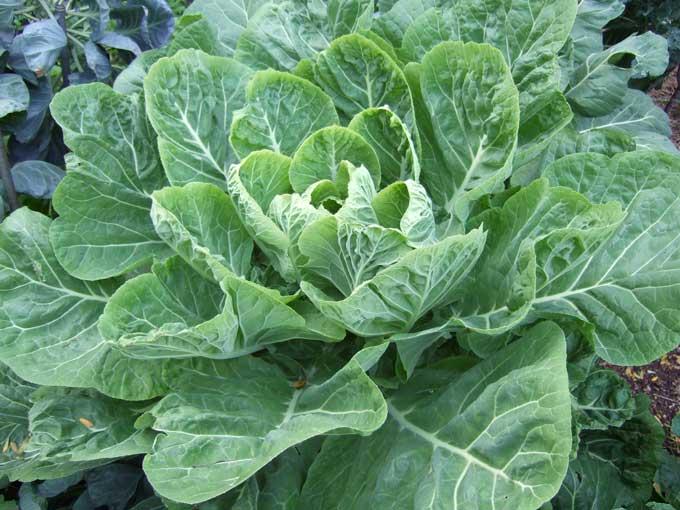Planting leafy green facts - collards, kale, mustard, turnips, and pac choi
- Hardiness: Biennials (plants that require two growing seasons to complete their life-cycle) but treated as annuals. Kale, collards, and turnip are hardy (can withstand heavy frosts in spring and fall); mustard is semi-hardy (can withstand light frosts, but not heavy frosts or freezing).
- Planting: In spring, plant seeds as soon as soil can be worked (3 to 4 weeks prior to frost date). Or start seeds indoors and plant 3 to 5-week old transplants into garden soil. To keep plants growing through the entire summer plant twice, in early spring and then late summer. For fall planting, determine the time to maturity (e.g. 55 days) add 10 to 14 days (“short day factor”), and plant seeds that many days prior to the first fall frost date (e.g. 65 to 69 days). As in the spring, transplants can also be grown or purchased for fall planting. Tolerates partial shade (4-6 hours of direct light/day).
- Days to maturity: 40 - 80 days from seed. These vegetables are quick to mature depending on variety, and can be harvested at various points in the growth cycle.
- Spacing: Kale, collard, and mustard: 12"- 24" in-row x 30"- 36" between rows for large plants. Closer spacing, 2- to 4-inches apart, produces a higher population of small plants that can be harvested repeatedly. As with most vegetables, closer spacing will result in smaller, “baby leaf” plants, and farther spacing will result in larger heads or plants. Turnip is spaced 4 inches apart in the row.
- Fertilizer needs: Medium requirement for nutrients, either from soil organic matter or fertilizers. Use starter fertilizer when transplanting, side-dress three weeks later. Refer to Fertilizing Vegetables for details.
- Approximate yield (per 10-foot row): 5 - 10 pounds.
Leafy green problems
Bolting
Cabbage looper
Harlequin bug
Imported cabbageworm
Whiteflies
Growing and care of leafy greens
- Incorporate compost into the soil before planting.
- Collards, kale, mustard, turnips, and pac choi are related to broccoli, cauliflower, and kohlrabi. They are tolerant of cooler temperatures and if winter is not too severe, kale will re-sprout from stems in the spring.
- They can be grown in spring and fall but fall may be the preferable season (except for collards) because they benefit from frost which increases the sugar content and flavor of the leaves.
- Turnips are a double benefit vegetable in that certain varieties can be grown to produce both greens and roots (eg. ‘Purple Top White Globe’ and 'Hakurei').
- Kale and turnip greens are more cold-tolerant than collards. Mustard greens are the least heat or cold-tolerant. Collards are more heat-tolerant than kale or turnip greens. The latter two can tolerate temperatures of 15 - 20°F. All greens can be grown well into the fall in the mid-Atlantic region using a protected garden location, floating row cover, or cold frame.
- Greens are relatively high in antioxidants, vitamins, and minerals making them an important part of home and community gardens. Cultivars with red and purple coloration tend to be higher in antioxidants (e.g., Asian purple mustard).
- Watering - Regular watering is required for succulent, fast-growing crops.
- Weeding - Hand-pull weeds or cut them at the soil line with a sharp hoe. Spread an organic mulch around plants to prevent weed germination and conserve soil moisture. If seeds are sown thickly, early weed competition could be minimal due to shading by vegetable plants. Thin extra plants as needed.
Harvesting
- Outer leaves, young leaves, or entire plants can be harvested.
- With the exception of pac choi where the entire plant is usually harvested, the outer leaves of leafy greens are usually harvested. Leaf yellowing and browning is a sign they are over-mature and should be composted.
- Alternatively, an area can be thickly sown with your favorite leafy green and thinned to an 8-inch spacing after they are 6 to 10 inches tall. These thinned plants are your first harvest, with future harvests coming from the outer leaves of the remaining plants.
- Turnip roots can be harvested throughout the fall.
- Cut-and-come-again harvesting: For continuous harvests of quick and easy salad greens, sow an area thickly with a mixture of your favorite greens. Shear the plants down to the crown with sharp scissors when they are 6- to 10-inches tall. They will quickly re-grow if watered and fertilized and be ready to cut a second time 2 - 3 weeks later. Turn under the plants when they become overly mature and bitter. Sow a second bed.
Storage and preservation
- Very cold (32°F), moist (95% RH) conditions, 2 to 3 weeks. Turnip roots can be heavily mulched and pulled or dug throughout the winter, as needed.
